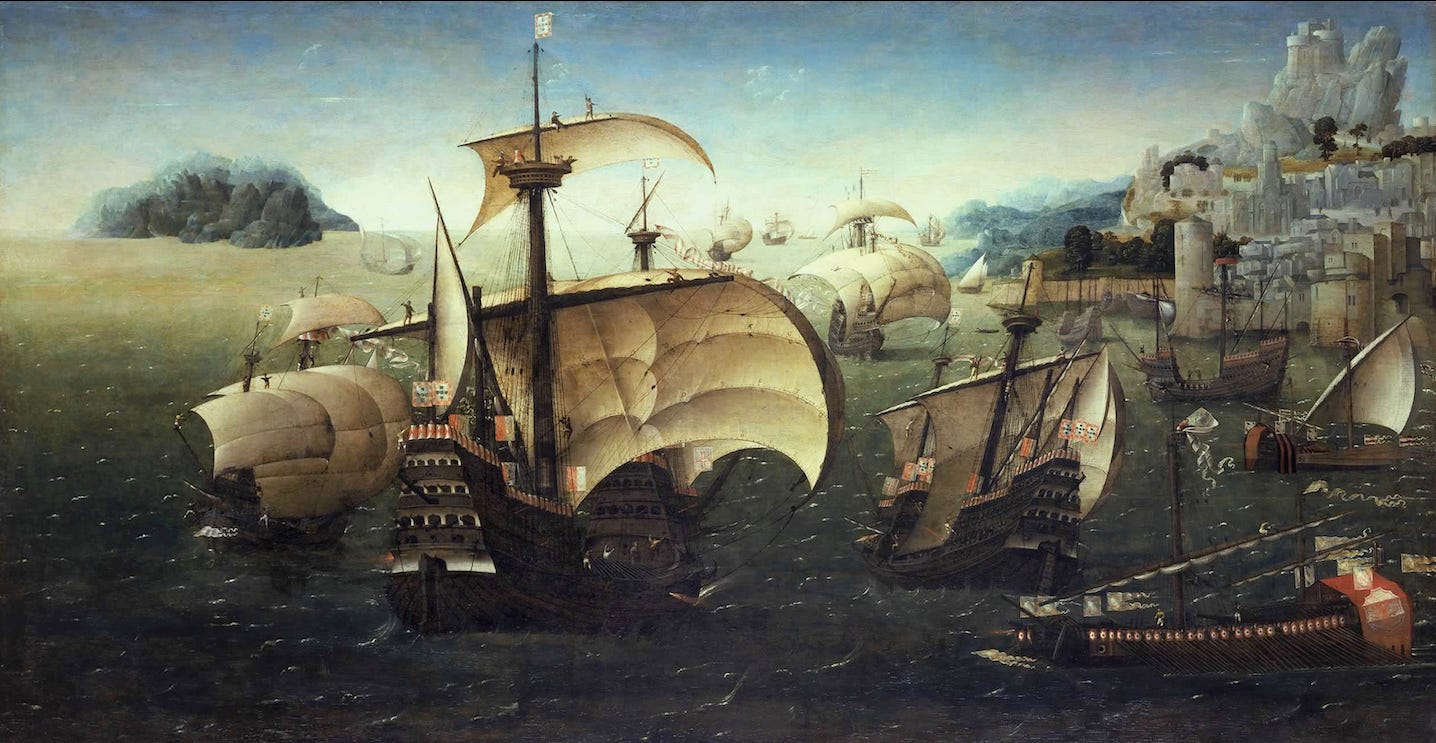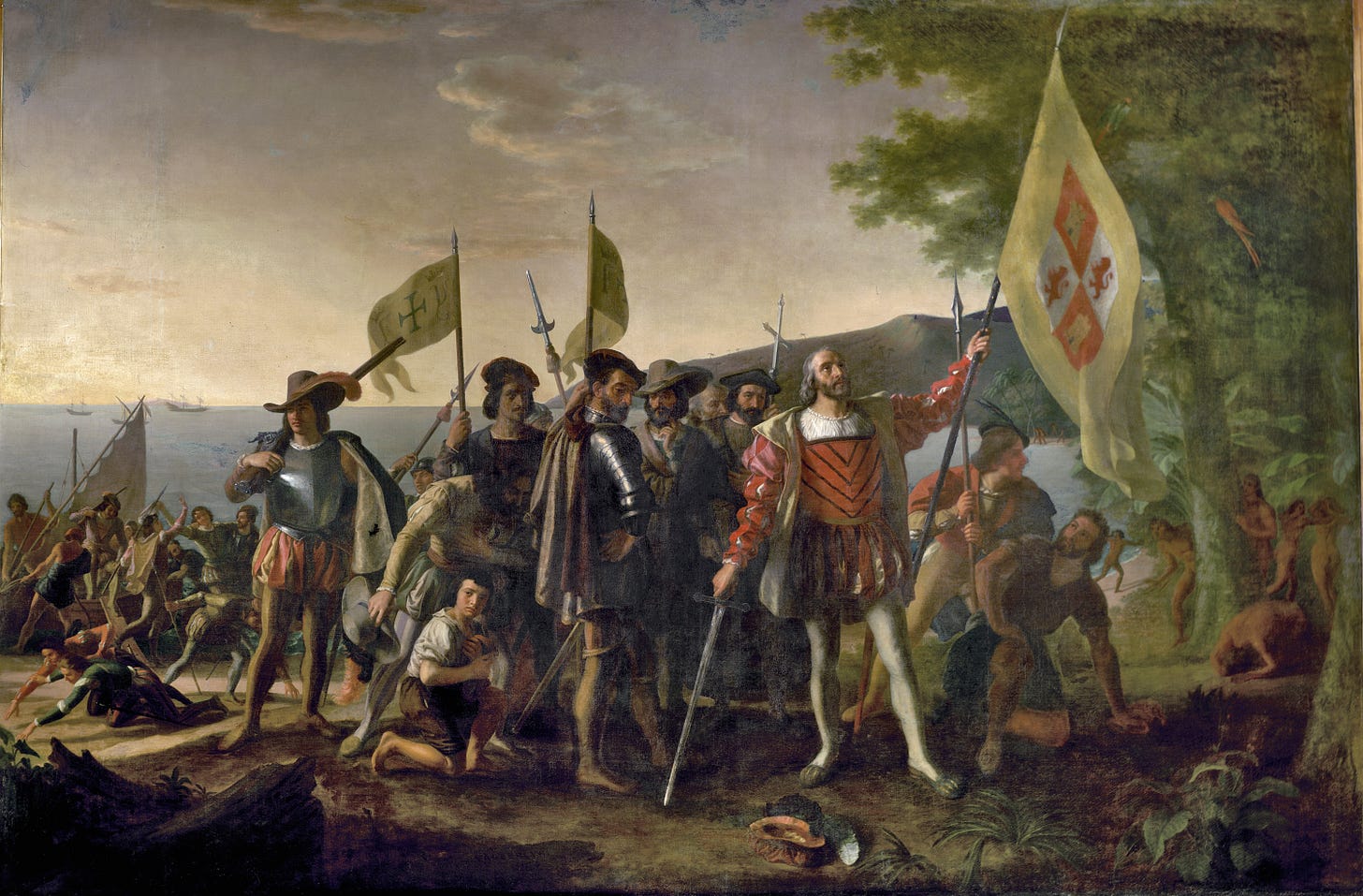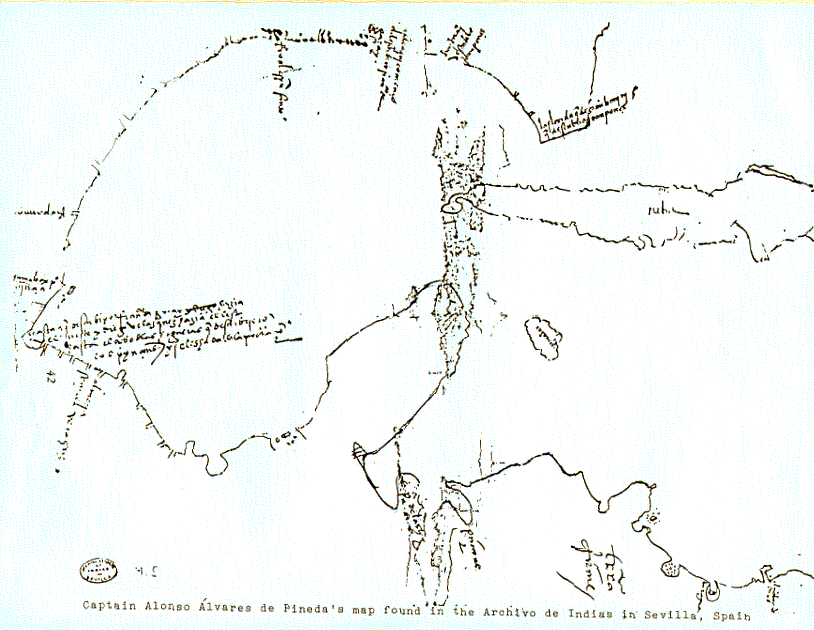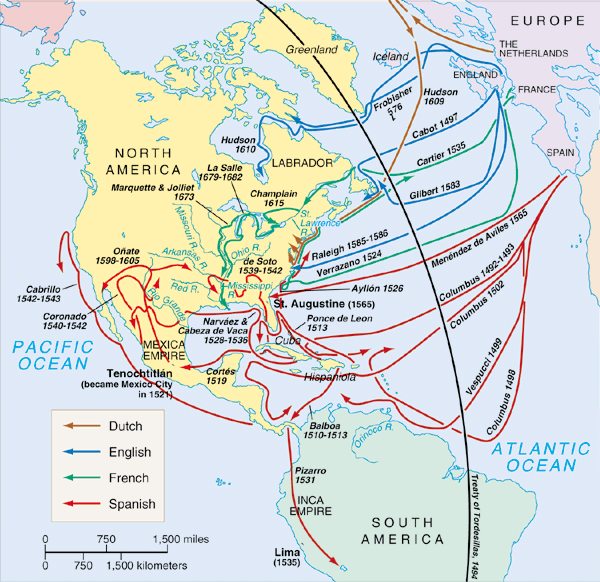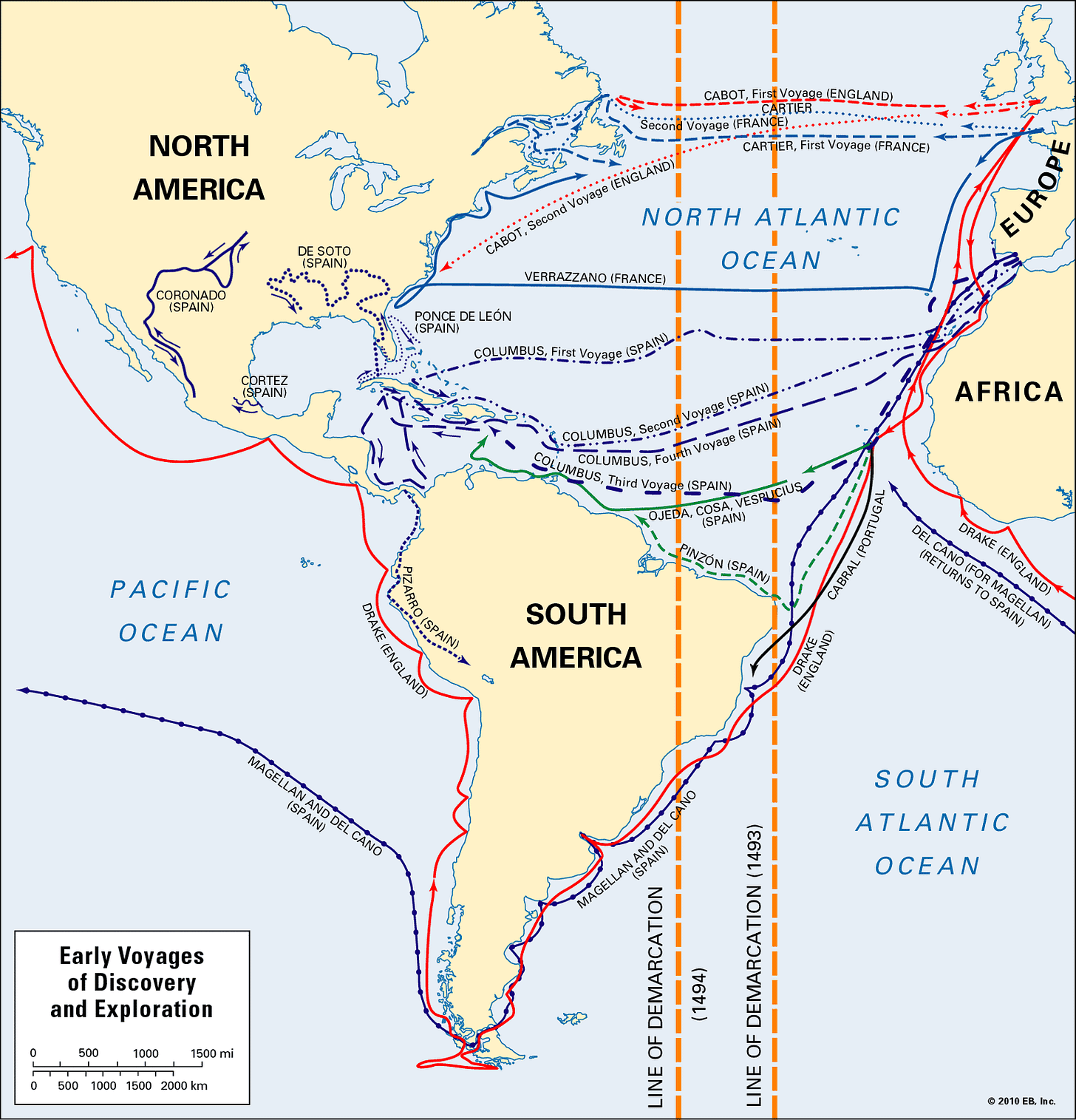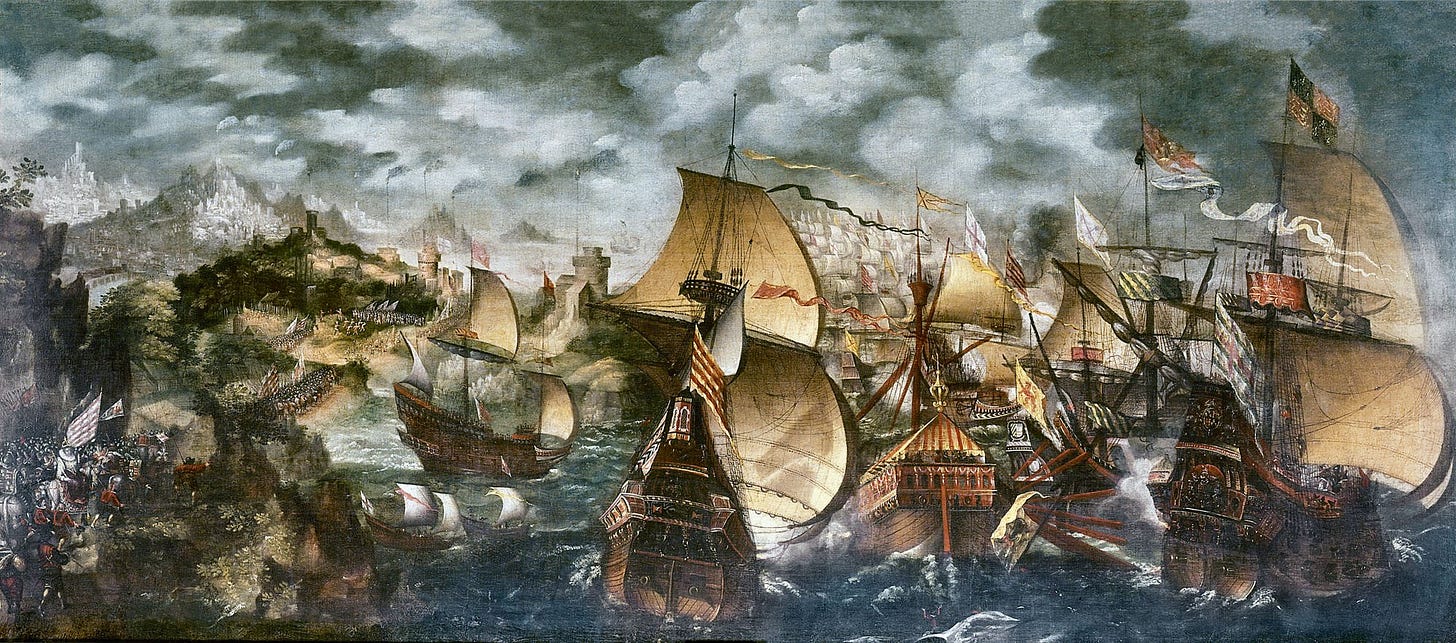Societies Collide: Age of Exploration, Discovery, and the "New World"
Roses are red, violets are blue, lots to unpack, Colonization starting in 1492.
Introduction
The Age of Discovery, and the Colonization that followed, connected the two halves of the World, or hemispheres. The eastern hemisphere, referred to as the "Old World," while the "New World" refers to the North and South Americas, or the western hemisphere. New ideas and scientific discoveries yielded new technologies and led directly to the Age of Exploration. The richest European Nations; Spain, France, England, Portugal and the Netherlands, were the ones motivated to explore and establish colonies, as they had the money to do it. Europeans were in search of wealth, power, and to spread their religions (God, Glory, Gold). Trade, wealth, and religion inspired exploration - and later - colonization; which would be entirely based on the labor of African slaves on land seized from Native Americans.
Once the New World's discovery became widely known to European monarchs, who chartered entire fleets to look for the fabled Northwest Passage through the American continent, seeking a connecting route to the lucrative spice and opium trade of Southeast Asia. A massive and aggressive land grab followed, helped along by the spread of European diseases to which the Natives had no immunity. As Europeans realized there was more money to be made by turning their focus to American regions and their natural resources. A Northwest Passage was eventually discovered, but due to Arctic ice caps it hasn't really been feasible in the past, however global warming has reignited interest in establishing more shipping routes over the top of the world. It was soon understood that Columbus had not reached Asia, but rather found what was to Europeans a New World, which in 1507 was named "America", probably after Amerigo Vespucci, an explorer.
Exploration
Portugal led the other European nations into exploration, although the Chinese and Zheng He, as well as several other cultures, had been engaging in long-distance maritime trade as well. Encouraged by Prince Henry the Navigator, Portuguese seamen sailed southward along the African coast, seeking a water route to the East. Henry established the Escola de Sagres as a school and financial institution that pioneered maritime trade and navigation. They were also looking for a legendary king named Prester John who had supposedly built a Christian stronghold somewhere in northwestern Africa. During Henry’s lifetime the Portuguese learned much about the African coastal area. His school developed the quadrant, the cross-staff and the compass, made advances in cartography, and designed and built highly maneuverable little ships known as caravels.
After Henry’s death, Portuguese interest in long-distance trade and expansion waned until King John II commissioned Bartolomeu Dias to find a water route to India in 1487. Dias sailed around the tip of Africa and into the Indian Ocean before his frightened crew forced him to give up the quest. A year later, Vasco da Gama succeeded in reaching India and returned to Portugal laden with jewels and spices. In 1500, Pedro Álvares Cabral discovered and claimed Brazil for Portugal, and other Portuguese captains established trading posts in the South China Sea, the Bay of Bengal, and the Arabian Sea. These water routes to the East undercut the power of the Italian city-states, and Lisbon became Europe’s new trade capital.
Next to get in on the exploration action was Spain, in 1492 Christopher Columbus made the first of his now-infamous voyages to the West Indies/Caribbean Islands. The monarchs of Spain, Ferdinand and Isabella, decreed a charter for him to make four voyages. Spain had recently led a brutal period of persecution against Jewish and Muslim people called the Inquisition. Convinced that they had created an ethno-state, Spain chartered and invested in the "New World," hoping to increase their wealth, power, and empire across the world.
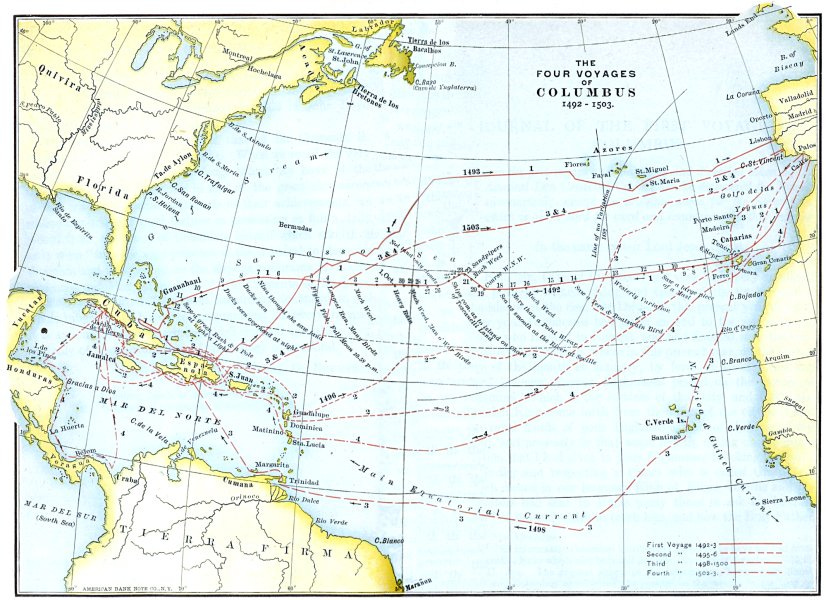
After word of Spain's "discovery" of North America spread, England, France, and others would continue to explore, claim territories, and war with each other for hundreds of years. After Columbus had traveled to North America and returned the second time, in 1497, an Italian explorer named John Cabot sailed by charter from the Kingdom of England and landed on the North American coast. Each of these European nations were searching for a fabled Northwest Passage to India, as the Indian Ocean Spice Trade there was the most lucrative market in the world.
There were several notable expeditions chartered to explore the American continents in the western hemisphere. In 1513 a Spanish conquistador named Ponce de León, a man who had sailed with Columbus on his second voyage in 1493, was chartered by the Spanish crown. He would "discover" and map the territory that we now know as Florida. The exact location of his expedition is disputed, but Ponce de León was the first known European to reach the present-day United States mainland. Later, in 1519, Alonzo Álvarez de Pineda would claim the territory around the Gulf Coast that is now Texas. The expedition established the remainder of the boundaries of the Gulf of Mexico while disproving the idea of a sea passage to Asia. It also verified that Florida was a peninsula instead of an island. Álvarez de Pineda became the first European to see the coastal areas of what is now western Florida, Alabama, Mississippi, Louisiana, and Texas, lands he called "Amichel". His map is the first known document of Texas history and was the first map of the Gulf Coast region of the United States. Today, it is stored at the Archivo General de Indias in Spain.
Also in 1519, another Spanish conquistador (or Spanish conqueror), Hernán Cortés, in an event stranger and certainly more brutal than fiction, arrived in Mexico with horses and 500 soldiers from Spanish plantation colonies in Cuba. Cortés and his men spent 2 years rapidly spreading smallpox (Old World disease Native Americans did not have immunity to) and conquering the Aztec capital of Tenochtitlánon for "New Spain."
One Spaniard wrote, “Some of our soldiers even asked whether the things that we saw were not a dream.” The Aztecs were unsure what to make of the strangers. They had never seen men dressed in metal armor and riding horses. Some mistook Cortés for the great Aztec god Quetzalcoatl and welcomed him as a hero.

In 1521, Portuguese sailor Ferdianand Magellan was chartered by Spain to find the Northwest Passage. Are you catching a theme here? Instead, Magellan's expedition would be the first to sail completely around the globe, or what we call circumnavigate.

In 1524 another Italian explorer named Giovanni da Verrazzano was commissioned (chartered) by King Francis I of France to find the Northwest Passage to India. Instead he was the first European to return to the Atlantic coast since Norse vikings, as far north as Narragansett Bay and Newfoundland (Canada). Vasco Núñez de Balboa, probably came the closest to a Northwest Passage three years earlier when he crossed the Isthmus of Panama and discovered the Pacific Ocean in 1521.
In 1527, the Narváez expedition was sent to New Spain to establish colonial settlements and garrisons in Florida. After being devastated by a Hurricane, most of the members died. Only four of the expedition's original 600 members survived. They reached Mexico City in 1536. One of the survivors was Alvar Nunez Cabeza de Vaca. These survivors were the first known Europeans, and the first African (a Moroccan servant in Spain, named Mustafa Azzemouri) to see the Mississippi River, and to cross the Gulf of Mexico and Texas. Cabeza de Vaca was one of the sources of a popular myth at the time, the Seven Cities of Gold.
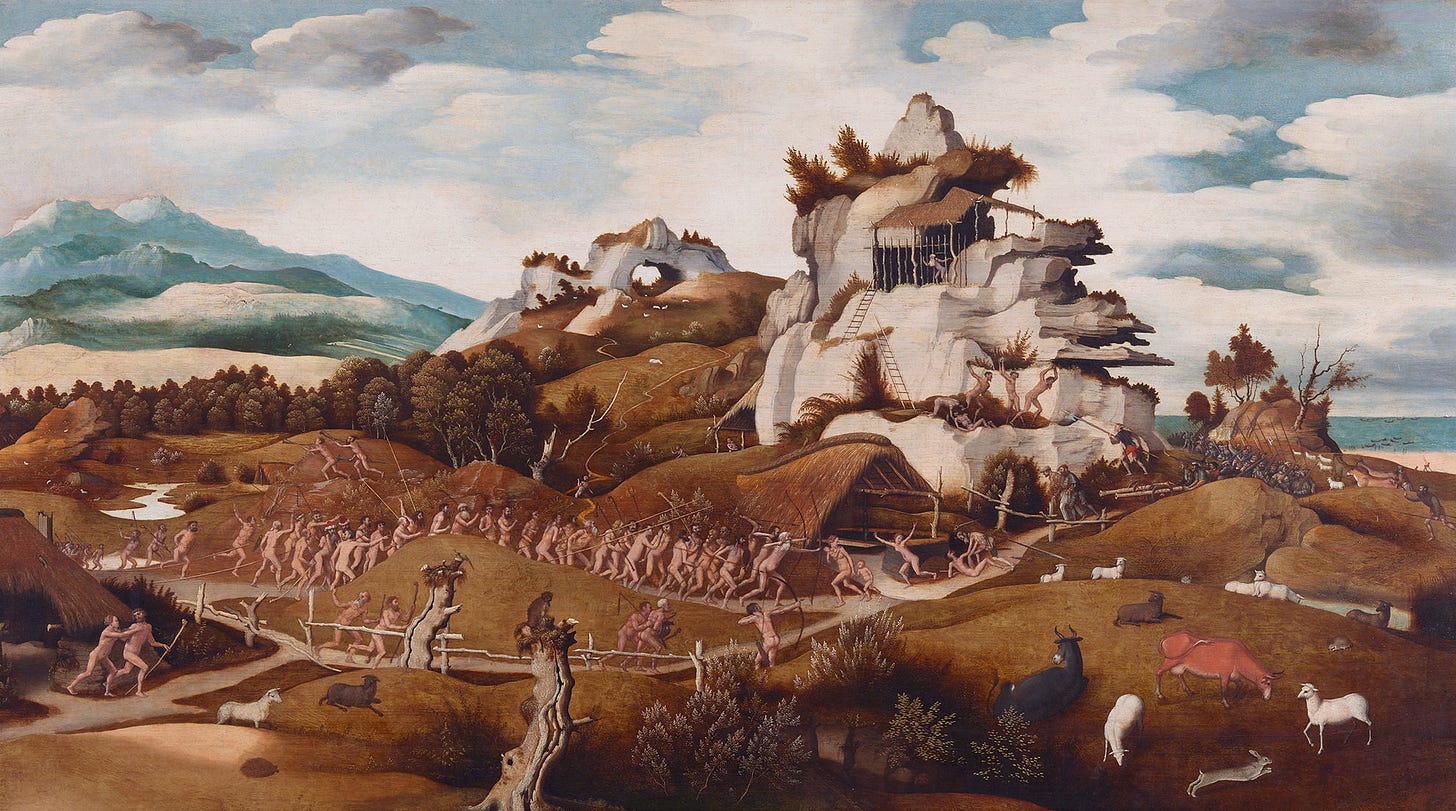
In 1532, Francisco Pizzarro conquered a powerful Incan Empire in present-day Peru, again with the help of smallpox. The disease swept through native communities with no immunity to European diseases, killing thousands. Similar to Cortés in Mexico, Pizarro captured the Incan ruler (named Atahualpa), demanded ransom, received the ransom, and then killed Atahualpa anyway. Pizarro was followed by Frenchman Jacques Cartier in 1534, who headed an expedition that explored the St. Lawrence River as far as present-day Montreal in Canada.
In 1535 and 1536, Pedro de Mendoza went as far as present-day Buenos Aires in Argentina, where he founded a colony. At the same time, Cabeza de Vaca explored the North American Southwest as far as California, adding that region to Spain’s New World empire.
Between 1540 and 1542, Spanish conquistador and explorer, Francisco Vázquez de Coronado led a large expedition from Mexico to present-day Kansas through parts of the southwestern United States. His expedition marked the first European sightings of the Grand Canyon and the Colorado River, among other landmarks. About the same time, Hernando de Soto explored southeastern North America from Florida to the Mississippi River.
In 1562, Frenchman Jean Ribault headed an expedition that explored the St. Johns River area in Florida, kicking off a colonizing competition between Spain, France, and England in North America that would eventually culminate into the Seven Years' War two centuries later. Two years later by a second venture was headed by René Goulaine de Laudonnière. But the Spanish soon pushed the French out of Florida, and thereafter, the French directed their efforts north and west of the Mississippi River watershed, attempting to establish various forts such as La Salle. The British had chartered the London and Virginia Companies as well, which would eventually succeed in establishing Jamestown in 1607. In 1608 Samuel de Champlain built a fort at Quebec and explored the area north to Port Royal and Nova Scotia and south to Cape Cod.
The Netherlands, including Holland, are known collectively as the Dutch. The Dutch were also engaged in the exploration of America through very early establishment of stock markets to help finance expeditions. Formerly a Protestant province of Spain, the Netherlands was determined to become a commercial power and saw exploration as a means to that end. In 1609, Henry Hudson led an expedition to America for the Dutch East India Company and laid claim to the area along the Hudson River as far as present-day Albany. In 1614 the newly formed New Netherland Company obtained a grant - or charter - from the Dutch government for the territory between New France and Virginia. About ten years later another trading company, the West India Company, settled groups of colonists on Manhattan Island and at Fort Orange, which would become New York when it was seized by the British. The Dutch also planted trading colonies in the West Indies, setting the roots for a worldwide trade empire that still exists today.




